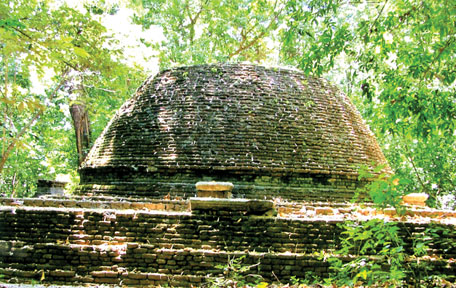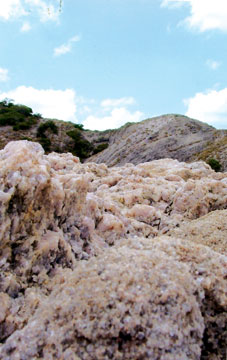|
20th anniversary of the Revolution of the Mora Tree:
Sacred site of historic artefacts
by Kumarasiri HETTIGE
There are ample evidence to prove that Sri Lanka's culture could
boast of traditions extending beyond 2500 years. Although the values of
this proud culture had fluctuated over the years the Sri Lankan bhikkhus
should invariably get the honour of protecting it for centuries. It is
an accepted fact that the Maha Sangha were the forerunners of the Sri
Lankan nation and culture.
 |
|
Ven. Rahula Thera |
Only a few Bhikkhus are engaged in national missions with far
reaching environmental importance having ventured beyond the traditional
timetable of the Bhikkhus who are expected to devote their lives and
energy for religious and social duties of Buddhists.
Treasure
This article is written on the occasion of the 20th anniversary of
the revolution initiated by a bhikkhu Priest who is engaged in such a
national mission.
It is indeed doubtful whether there is anybody in Sri Lanka today who
is not aware of Asia's biggest pink quartz deposit belonging to the
pre-historic era of 550 million years ago and the biggest Na forest
located in Sri Lanka.
This national treasure that has attracted the attention of the whole
world was a mere forest reserve in the Mahaweli 'H' Zone just two
decades ago.
Namal Uyana
It was, then known as Galappalle Lunugal Debala and Na forest. At a
time when the present National Namal Uyana was being stripped of her
natural beauty by the relentless onslaught of illicit timber dealers and
hunters, this area attracted the attention of Ven. Rahula Thera residing
at a close-by temple at Ranawa as a result of some information passed on
to him in a dream.
When Ven. Rahula Thera visited the site described in the dream he was
able to catch the sight of not only Na trees but also some ruins of an
ancient Buddhist place of religious worship, including a bodhi chamber,
dagaba, statues etc.
A special object that caught the eyes of Ven. Rahula Thera who had a
natural inclination for nature was a stone receptacle filled with water
that was carried in a small stream flowing along the forest.
 |
|
Ancient dagaba |
While these legacies of nature were there on one side, a historic
Buddhist sacred place was also there on the other side. The Buddhist
ruins were scattered all over the place. The bio-diversity of the site
was enhanced with the presence of mammals, reptiles, fish, birds and
numerous species of plants. They were really pleasing to the eyes as
well.
Challenging task
Ven. Rahula Thera had never entertained any misgivings about
fulfilling his duty in performing the challenging task of identifying
this site not only as a magnanimous creation of the mother nature but
also as a centre which gave prominence to the martial capabilities of
the ancient Sinhalese It was a meditation centre for the Bhikkhus with
all the facilities necessary for the achievement of their goals in
meditation and preserving the site safely and securely with a view to
presenting it to the future generations.
Emboldened by this attitude the Thera ventured to act as the
veritable defender of the site having set up a camp on a Mora tree at a
height of about 40 feet from the ground on March 28, 1991, disregarding
the grave dangers posed by venomous reptiles and other wild beasts
including wild elephants.
However, it was no easy task for a bhikkhu. He had to face the wrath
of illicit timber merchants as well as inhuman hunters.
Pink quartz
In spite of the various undesirable elements who had got together to
drive away Ven. Rahula Thera from the site, his conscience did not allow
him to shirk the responsibility of preserving the sacred site consisting
of numerous historic artefacts, for the benefit of future generations.
 |
|
Pink quartz deposit |
The biggest pink quartz deposit in South Asia and the largest Na
forest in the island that caught the limelight of the people as a result
of the revolution on the Mora tree launched on March 28, 1991 have
attracted the keen attention of the whole world today. At a time when
national parks of our country, which have been declared world heritages
and named after the white imperialists who had no love for indigenous
culture or the environment, the National Namal Uyana is the only plot of
land at national level which is identified by an indigenous name that is
in keeping with our culture.
Great insight
Rahula Thera was rewarded with the Presidential Environment Award in
2004, the Sri Lanka green Award and also awards from the Sri Lanka
Ramanna Sect and the Sri Lanka Amarapura Sect. for his valuable noble
deeds, proving the point that there are still grateful people in this
island.
Thanks to his great insight he took action in 2003 to hand over this
national treasure to the Department of Forests with a view to ensuring
State protection for the site. The chairmanship of the National Namal
Uyana Conservation Trust is presently graced by Namal Rajapaksa, MP. It
is expected that he will render yeoman service for the maintenance and
development of this national treasure in view of the fact that the
President is a national leader who was born and bred in the natural
environment of a village in the Ruhuna. While expressing my heartiest
greetings on this occasion of the 20th anniversary of National Namal
Uyana, let me also express my best wishes for long life to Ven. Rahula
Thera who is engaged in a great national endeavour in protecting and
preserving the national environment.
The writer is co-ordinating Secretary to the President (Parliamentary
affairs) and Secretary to the Jathika Namal Uyana Development Trust.
|

